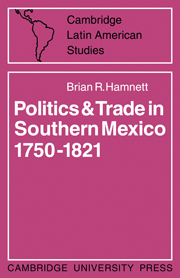Book contents
- Frontmatter
- Contents
- Acknowledgments
- Archival abbreviations
- Weights, measures, and currency
- Introduction
- 1 Oaxaca—environment and trade
- 2 The struggle for control of trade
- 3 The problem of reform, 1768–1786
- 4 Reform and reality—the crisis of the subdelegations in the 1790s
- 5 The Gálvez Plan under fire, 1786–1804
- 6 Finance, trade, and the merchants, 1789–1808
- 7 The political crisis of 1808–1821
- 8 Conclusion—Oaxaca within the context of Mexican politics
- Glossary of Personnel
- Appendices
- Sources and bibliography
- Maps
- Index
7 - The political crisis of 1808–1821
Published online by Cambridge University Press: 04 August 2010
- Frontmatter
- Contents
- Acknowledgments
- Archival abbreviations
- Weights, measures, and currency
- Introduction
- 1 Oaxaca—environment and trade
- 2 The struggle for control of trade
- 3 The problem of reform, 1768–1786
- 4 Reform and reality—the crisis of the subdelegations in the 1790s
- 5 The Gálvez Plan under fire, 1786–1804
- 6 Finance, trade, and the merchants, 1789–1808
- 7 The political crisis of 1808–1821
- 8 Conclusion—Oaxaca within the context of Mexican politics
- Glossary of Personnel
- Appendices
- Sources and bibliography
- Maps
- Index
Summary
The news of the fall of Godoy and Charles IV, and of the succession of Ferdinand VII reached Mexico City on 8 June 1808. A fortnight later came the news of the departure of the Royal family for Bayonne, and of the Dos de Mayo rising in Madrid against the French occupation forces. On 14 July the arrival of the Madrid newspapers brought word of the Bayonne renunciations in favour of Napoleon, and the circular order of the Council of Castile commanding recognition of French authority throughout the Spanish Indies.
The knowledge of these events led to a power struggle in Mexico City between the Creole lawyers of the Ayuntamiento of Mexico, and the Peninsular lawyers of the Audiencia, and their allies, the Peninsular merchants of the Mexico Consulado. When Viceroy Iturrigaray's unilateral suspension of the Consolidation on 9 August 1808 failed to quieten animosities, he was forced to adopt an increasingly more open position in favour of the Creoles. As the Creole lawyers, Azcárate and Verdad, began to claim that sovereignty had returned to the people in default of a king, the Peninsulares believed that the ending of Spanish Metropolitan rule in Mexico was about to take place.
Therefore, they conceived of a quick coup to remove the Viceroy and his Creole associates in the Mexico Ayuntamiento. This conspiracy centred on the Audiencia and Consulado of Mexico. It was known to the Inquisitor, Alfaro, to the Archbishop of Mexico, Lizana, and to the chief Peninsular merchants and land-owners.
- Type
- Chapter
- Information
- Politics and Trade in Mexico 1750–1821 , pp. 121 - 147Publisher: Cambridge University PressPrint publication year: 1971

